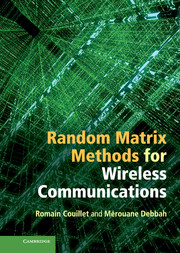Preface
Published online by Cambridge University Press: 07 October 2011
Summary
More than sixty years have passed since the 1948 landmark paper of Shannon providing the capacity of a single antenna point-to-point communication channel. The method was based on information theory and led to a revolution in the field, especially on how communication systems were designed. The tools then showed their limits when we wanted to extend the analysis and design to the multiterminal multiple antenna case, which is the basis of the wireless revolution since the nineties. Indeed, in the design of these networks, engineers frequently stumble on the scalability problem. In other words, as the number of nodes or bandwidth increase, problems become harder to solve and the determination of the precise achievable rate region becomes an intractable problem. Moreover, engineering insight progressively disappears and we can only rely on heavy simulations with all their caveats and limitations. However, when the system is sufficiently large, we may hope that a macroscopic view could provide a more useful abstraction of the network. The properties of the new macroscopic model nonetheless need to account for microscopic considerations, e.g. fading, mobility, etc.We may then sacrifice some structural details of the microscopic view but the macroscopic view will preserve sufficient information to allow for a meaningful network optimization solution and the derivation of insightful results in a wide range of settings.
Recently, a number of research groups around the world have taken this approach and have shown how tools borrowed from physical and mathematical frameworks, e.g. percolation theory, continuum models, game theory, electrostatics, mean field theory, stochastic geometry, just to name a few, can capture most of the complexity of dense random networks in order to unveil some relevant features on network-wide behavior.
- Type
- Chapter
- Information
- Random Matrix Methods for Wireless Communications , pp. xiii - xivPublisher: Cambridge University PressPrint publication year: 2011



